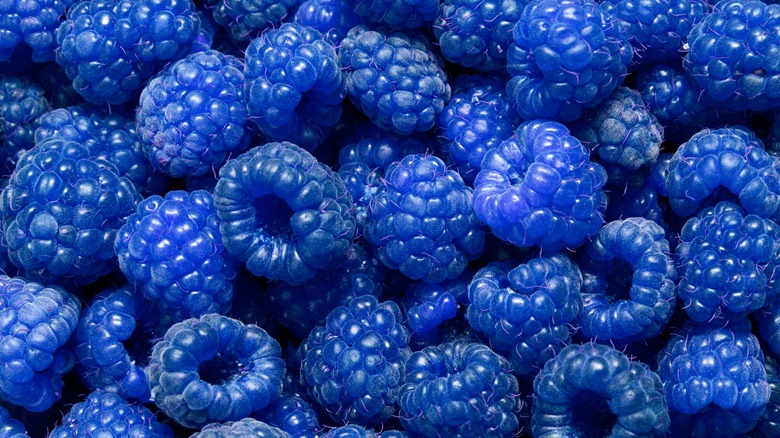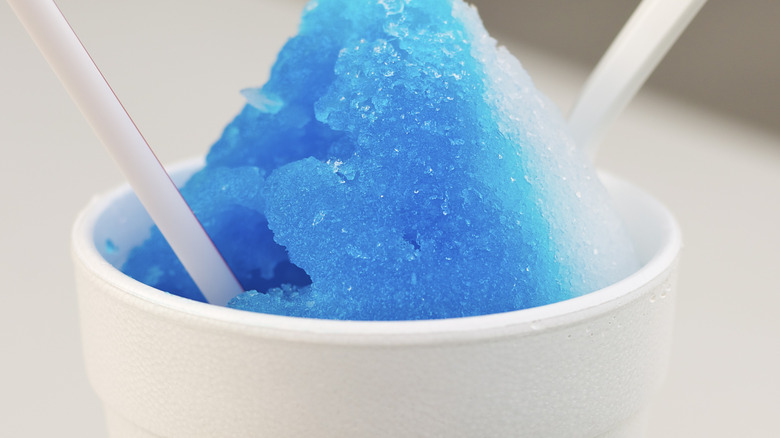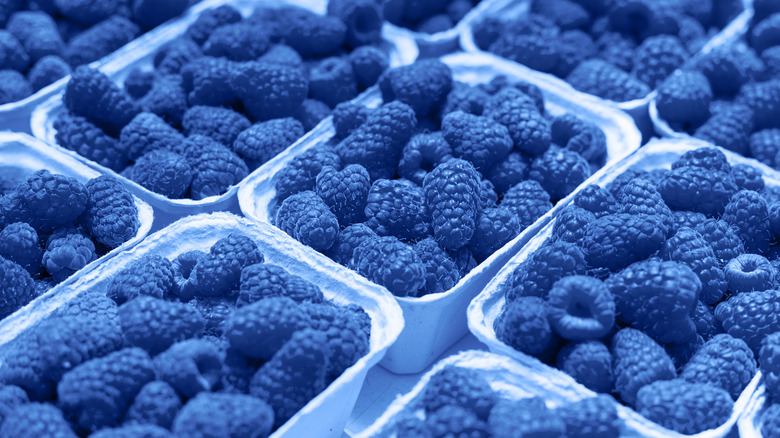Blue Raspberry Flavor Was Invented To Replace A Controversial Ingredient
A fluorescent blue tongue is the typical aftermath of indulging in a sweet delight reminiscent of childhood. Among all the candies, sodas, sports drinks, cocktails, slushies, and everything in between, settling on the brightest shade of blue is a badge that represents boldness, innocence, and marching to the beat of one's own drum. While this can certainly apply to selecting blueberry, blue moon, or butterfly pea flower off the menu, we're talking about a flavor that's as mysterious as it is mouthwatering.
Blue raspberry is, in and of itself, a symbol of innovation and rebellion. Blue raspberry, sadly enough, is not a real fruit. However, the artificial extract has become an iconic element of culinary culture. Moreover, its vivid hue is associated with its one-of-a-kind zest.
The first-ever blue raspberry-flavored product is one that is primarily enjoyed during the summer months — the good ol'-fashioned snow cone. Here's the story of how the frozen novelty introduced an entirely new flavor and color to the food world.
How blue raspberry got its start
Smart entrepreneurs understand that, in order to make their offering stand out, it needs to look, sound, feel, or taste different. Blue raspberry was born in the mid-20th Century when a blue-colored concentrate that certainly tasted fruity but remained distinctive was invented. Legend states that the original blue raspberry product was none other than the snow cone. Gold Medal, the Cincinnati-based company behind the Sno-Kone brand, added blue raspberry to its lineup in 1958. To this day, blue raspberry remains a bestseller. Then, in the 1970s, ICEE, the iconic slushie drink, debuted blue raspberry.
The flavor is still trendy years later and when the frozen drink company asked its Facebook followers to choose between it and classic cherry, many of them rushed in to say there was no competition and blue raspberry was their go-to flavor. Although cherry received a fair amount of votes and some even preferred to mix the two options together, it's clear that many fans have special memories of the electric-colored offering. Crumbl Cookies even collaborated with ICEE in July 2022 on a limited-time treat with blue raspberry frosting. Since it's so ingrained in our cultural palette, you may be surprised to learn that it came to be when a particular ingredient was banned.
The bizarre history of blue raspberry
The blue-colored, lab-created flavor came to be after amaranth, commonly known as Red No. 2, was banned by the U.S. Food and Drug Administration. Amaranth is an ingredient that was used in many raspberry-flavored treats, but it tended to cause severe reactions in some consumers, leading to major health concerns. In an attempt to solve the issue and keep raspberry goodies alive, food companies cleverly began using Blue No. 1 — aka Brilliant Blue — to represent the beloved prickly fruit, according to North Dakota State University.
While it was created in the laboratory, you may wonder if there are raspberries with the bright color associated with the artificial flavor. Unfortunately for its fans, there are no shockingly colored fruit in nature. However, there is a plant that produces darker blue, purple, and blackberries called Rubus leucodermis. These blackcap raspberries are found in the wild but are not used to make the treats so many people enjoy. Ingredients from other plants may be used in some cases: For example, ICEE's formula incorporates yucca and quillaia extracts.
Over the years, blue raspberry has become a mega-popular option for foods, beverages, cosmetics, and home fragrances. Munching on a blue raspberry snow cone, ice pop, or any other dessert brings joy to kids and adults alike. Not only does the color blue stand out among the rainbow assortment, but the unique flavor tastes pretty amazing, plain and simple.


